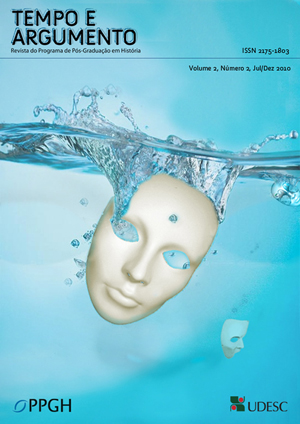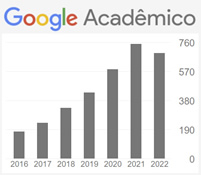De volta para Goiás e Minas Gerais: retornados, imaginações Geográficas e seus descontentamentos
DOI:
https://doi.org/10.5965/2175180302022010121Palabras clave:
imigração brasileira, Brasil, transnacionalismo, geografia cultural, geografia étnicaResumen
Processos migratórios para os Estados Unidos são tanto sobre os emigrantes que deixam o Brasil quanto sobre aqueles que ficam, e também sobre aqueles que voltam para o Brasil (os retornados). A imigração brasileira para os Estados Unidos é um fenômeno relativamente recente, que recebeu seu apogeu nos anos 80 com números sem precedência. Como que estes imigrantes brasileiros estão formando e (re)criando novos lugares e espaços, e o que acontece no retorno para o Brasil? Como que os retornados experimentam mudanças em suas vidas em duas comunidades de origem no Brasil depois de terem vivido em duas comunidades de destino nos Estados Unidos? Esse artigo usou extratos selecionados das 273 entrevistas informais e formais (nos dois países), que avaliam as mudanças por causa das migrações. Brasileiros (re)criam espaços transnacionais através de praticas sociais, culturais, e econômicas em lugares de destino, mas também incorporam e adicionam novos elementos em suas vidas em seus lugares de origem em Piracanjuba, Goiás, e Governador Valadares, Minas Gerais. No entanto, homens e mulheres vivenciam diferentemente o processo migratório. Homens tendem a se sentirem emasculados nos Estados Unidos e são mais felizes no Brasil, enquanto mulheres tendem a indicar um índice mais alto de felicidade nos Estados Unidos.
Descargas
Citas
ALMEIDA, Z. M. DE. 2003. Fazer a América: Inserção e Mobilidade do Imigrante Brasileiro em uma Economia de Base Étnica. Minas Gerais, Brazil: Unileste Edições.
AMERICAN COMMUNITIY SURVEY, U.S. CENSUS BUREAU 2007. S0201. Selected Population Profile in the United States, Country of Birth: Brazil; Data Set: 2007:http://factfinder.census.gov/servlet/IPTable?_bm=y&- reg=ACS_2007_1YR_G00_S0201:733;ACS_2007_1YR_G00_S0201PR:733;ACS_2007_1YR_G00_S0201T:733;ACS_2007_1YR_G00_S0201TPR:733&-qr_name=ACS_2007_1YR_G00_S0201&-qr_name=ACS_2007_1YR_G00_S0201PR&-qr_name=ACS_2007_1YR_G00_S0201T&-qr_name=ACS_2007_1YR_G00_S0201TPR&-ds_name=ACS_2007_1YR_G00_&-TABLE_NAMEX=&-ci_type=B&-redoLog=false&-geo_id=01000US&-format=&-_lang=en
BASCH, L., N. G. SCHILLER, AND C. S. BLANC. 1995. From Immigrant to Transmigrant: Theorizing Transnational Migration, Anthropological Quartely 6(1): 48-63.
BESERRA, B. 2003. Brazilian Immigrants in the United States: Cultural Imperialism and Social Class. New York: LFB Scholarly Publishing LLC.
BERRY, K. A. AND M. L. HENDERSON (EDS.) 2002. Geographical Identities of Ethnic America. Reno, Nevada: University of Nevada Press.
BRAZILIAN MINISTRY OF FOREIGN RELATIONS 2002. Ministerio de Relações Exteriores. [www.mre.gov.br/portugues/questoes/dowload/rcn2002.xls]
BRETTELL, CAROLYN B. AND JAMES F. HOLLIFIELD (EDS). 1999. Migration Theory: Talking Across Disciplines. New York: Routledge.
BRETTELL, C. B. 1999. Theorizing Migration in Anthropology. The Social Construction of Networks, Identities, Communities, and Globalscapes. In Migration Theory: Talking Across Disciplines, edited by C. B. Brettel andJ. F. Hollifield, 109-135. New York: Routledge.
CASTLES, S., AND M. J. MILLER 2003. The Age of Migration. Third Edition. New York: The Guildford Press.
DA MATTA, R. 1985. A Casa e a Rua. Rio de Janeiro Brazil: Editora Brasiliense.
FALCONI, J. L.. AND J. A. MAZZOTI (Eds.) 2007. The Other Latinos.Harvard University David Rockefeller Center for Latin American Studies. Cambridge, Massachusetts: Harvard University Press.
FRAZIER, J. W. AND E. L. TETTY-FIO (Eds) 2006. Race, Ethnicity, and Place in a Changing America. Harpur College, New York, State University of New York at Binghamton: Global Academic Publishing.
GOZA, F. 1999. Brazilian Immigration to Ontario, International Migration, 37(4): 765-799.
KAPLAN, D. H. AND W. LI (Eds). 2006. Landscapes of the Ethnic Economy.Lanham, Maryland: Rowman and Littlefield Publishers.
LEVITT, P. 2001. The Transnational Villagers.Los Angeles and Berkeley: University of California Press.
___. 2004. Transnational Migrants: When “Home” Means More Than One Country, Migration Information Source.
___. 2007. God Needs No Passport. Immigrants and the Changing American Religious Landscape.New York: The New Press.
MARCUS, A. P. 2008. Why so Many Lapses on Brazil and “Latin” America, Association of American Geographers Newsletter Op-ed, October (p.15).
__2009a. (Re)Creating Places and Spaces in Two Countries: Brazilian Transnational Migration Processes. Journal of Cultural Geography (26) 2: 173-198.
___2009b. Brazilian Immigration to the United States and the Geographical Imagination. Geographical Review 99:4.
MARGOLIS, M. L. 1994. Little Brazil: An Ethnography of Brazilian Immigrants in New York City. Princeton, New Jersey:Princeton University.
___. 1995. Brazilians and the 1990 United States Census: Immigrants, Ethnicity, and the Undercount, Human Organization, 54:52-59
___. 1998. An Invisible Minority: Brazilians in New York City. New York: Simon and Schuster.
___. 2006. Bibliography of Brazilian Emigration. BRASA (Brazilian American Studies Association): [www.brasa.org].
MARROW, H. B. 2003. To Be or Not To Be (Hispanic or Latino): Brazilian Racial and Ethnic Identity in the United States Ethnicities (3): 427-64.
___. 2004. Coming to Grips with Race: Second-Generation Brazilians in the United States. A paper presented at the BRASA Congresso Internacional VII, Brazilian Studies Association (BRASA). June 9- 12, 2004. Pontifícia Universidade Católica do Rio de Janeiro (PUC-RJ), Rio de Janeiro, Brazil.
MARTES, A. C. B 2000. Brasileiros nos Estados Unidos: um estudo sobre imigrantes em Massachusetts. Brazil: Paz e Terra.
MARTES, A. C. B, AND W. SOARES 2006. Remessas de recursos dos imigrantes, Estudos Avançados 20 (57): 41-54.
MOREIRA, I. 2007. “Dolar a R$2 gera crise em cidade de MG.” In Valor, Especial, August 28, pp. A16.
McDONNELL, J., and C. de LOURENCO, Cileine 2009. You're Brazilian, right? What kind of Brazilian are you? The racialization of Brazilian immigrant women, Ethnic and Racial Studies, 32(2) 239-256.
MIYARES I. M. and C. A. AIRRIESS (Eds) 2007. Contemporary Ethnic Geographies in America.Lanham, Maryland: Rowman and Littlefield Publishers.
PARKER, R. G. 1991. Bodies, Pleasures, and Passions. Sexual Culture in Contemporary Brazil.Boston, Massachusetts: Beacon Press.
REBHUN, L. 1999. The Heart is Unknown Country. Love in the Changing Economy of Northeast Brazil. Stanford, CA: Stanford University Press.
REEL, M. 2006. Losing Its Young to an American Dream, Men Depart, Dollars Return to Transform A Brazilian City, Washington Post, November 14, 2006; Page A22.
SALES, T. 1998. Brasileiros Longe de Casa. São Paulo, Brazil:Editôra Cortez.
SIQUEIRA, S. 2006. Migrantes e Empreendedorismo na Microregião de Governador Valadares – Sonhos e Frustrações no Retorno. Disertação de doutorado., Ciências Humanas, Sociologia e Política, Universidade Federal de Minas Gerais UFMG, Brasil.
TSUDA, T. 1999. The Permanence of ‘Temporary’ Migration: The ‘Structural Embededness’ of Japanese-Brazilian Immigrant Workers in Japan. The Journal of Asian Studies, 58 (3): 687-722.
U.S. CENSUS BUREAU 2000a. Summary File 3, PCT 19 [http://factfinder.census.gov/servlet/DTTable?_bm=y&-state=dt&- ds_name=DEC _ 2000_SF3_U&-CONTEXT=dt&- mt_name=DEC_2000_SF3_U_PCT019&-_caller=geoselect&-geo_id=01000US&-geo_id=NBSP&-format=&-_lang=en]
U.S. CENSUS BUREAU 2000b, Public Law 94,171: [http://quickfacts.census.gov/qfd/meta/long_68188.htm]
U.S. DEPARTMENT OF HOMELAND SECURITY (Office of Immigration Statistics, Policy Directorate) 2005. Border Apprehensions 2005. Written by Amy Wy: [www.dhs.gov/xlibrary/assetts/statistics/publications/ois_apprehensions_fs_2005.pdf]
___2006. Estimates of the Unauthorized Immigrant Population Residing in the United States: January 2006. Written by Michael Hoefer, Nancy Rytina, and Christopher Campbell: [www.dhs.gov/xlibrary/assets/statistics/publications/ill_pe_2006.pdf] Recebido: Setembro/2009 Aprovado: Agosto/2010
Descargas
Publicado
Cómo citar
Número
Sección
Licencia
Derechos de autor 2010 Tempo e Argumento

Esta obra está bajo una licencia internacional Creative Commons Atribución-NoComercial 4.0.
Os artigos cujos autores são identificados representam a expressão do ponto de vista de seus autores e não a posição oficial da Tempo e Argumento.





